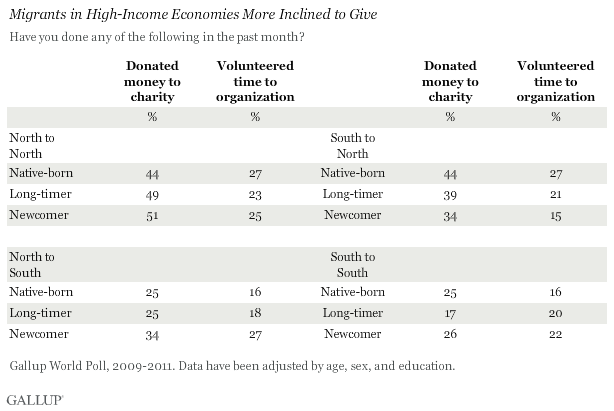WASHINGTON, D.C. -- Migrants in high-income countries are more inclined than those in middle- to low-income countries to give their time or money back to the communities they live in, but all migrants' commitment to their communities changes the longer they live in them.

These findings are based on Gallup World Poll interviews with nearly 25,000 first-generation migrants and 442,000 native-born residents in 150 countries between 2009 and 2011. The large sample enables Gallup to divide migrants into two categories -- newcomers (who moved to their destination country less than five years ago) and long-timers (who have lived in their current country for at least five years) -- and compare their life experiences with the native-born. Gallup also groups migrants and the native-born by whether they live in high-income economies (referred to as "the North") or middle- to low-income economies (referred to as "the South").
In general, people in the low- to middle-income countries are less likely than those in high-income countries to say they have volunteered their time to an organization or donated their money to charity in the past month. This could partly reflect how participation in formal volunteer organizations remains a relatively nascent concept in many parts of the developing world. Much of the volunteerism that takes place in Arab countries, for example, does so outside of formal organizations in informal neighborhood arrangements or ad hoc community projects.
Yet studying civic engagement or participation remains important -- regardless of where people live -- given the strong, positive relationships Gallup finds between it and multiple elements of well-being as well as measures of community institutions, job creation, diversity, and youth development.
Migrants in High-Income Countries More Involved in New Country Than Old
Migrants who have moved from one high-income country to another (North to North) are as likely as the native-born to say they have volunteered their time to an organization, with roughly one in four in each group donating their time. But these migrants are even slightly more likely to say they donated their money to charity in the past month, with about half of long-timers (49%) and newcomers (51%) donating funds versus 44% of the native-born.
When migrants from low- to middle-income countries initially arrive in high-income countries (South to North), however, they are not as likely to volunteer or donate money as much as the native-born do. Their civic participation does increase the longer these migrants stay in their adopted country, but not to the level observed among the native-born population.
Still, Gallup finds North-North long-timer migrants and South-North long-timer migrants are more involved in their new country than they were in the country they left: North-North long-timers are more likely to volunteer their time, and South-North long-timers are more likely to donate their money.
New Migrants in Low- to Middle-Income Countries More Generous
When migrants who move from high-income countries to low- to middle-income countries arrive, they at first exhibit the same type of behavior they did in their home countries -- a higher percentage of them volunteer their time (27%) and donate their money (34%) than the native-born do. But as long-timers, their likelihood to give back to their communities drops off -- to the same the level as the native-born.
Migrants who move from one low- to middle-income country to another are more likely to volunteer their time than the native-born. Newcomers and the native born are as likely to donate their money; long-timers are less likely to donate money than the other two groups.
Implications
Migrants' proclivity toward giving back to their communities can benefit their adopted communities. Policymakers would be wise to find out ways to maintain this inclination to give as long as migrants remain in the country. Social scientists note that broad-based civic engagement can promote acceptance and inclusiveness, providing a source of positive shared experiences between groups with a history of tension. In fact, Gallup finds strong positive relationships between its measures of civic engagement and community diversity, including the belief that communities are good places for racial and ethnic minorities as well as migrants to live.
For complete data sets or custom research from the more than 150 countries Gallup continually surveys, please contact us.
Survey Methods
Results are based on Gallup World Poll data collected across 150 countries and areas in 2009, 2010, and 2011. The typical sample size was 1,000 adults, aged 15 and older, per country per year. Projection weighting was performed so that each country's data are proportional to the total world population. A total of 466,689 adults were included in the analysis, including 441,901 native-born residents and 24,788 first-generation migrants. Countries were classified as "North" (high-income economies) or "South" (middle- to low-income economies) according to World Bank categories. Migrants surveyed were born in 188 countries (51 of which were in the North and 137 were in the South) and lived in 150 destination countries (40 in the North and 110 in the South).
For more complete methodology and specific survey dates, please review Gallup's Country Data Set details.
